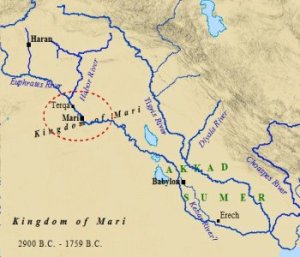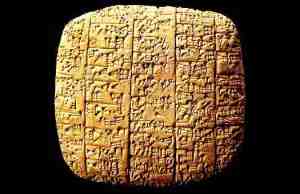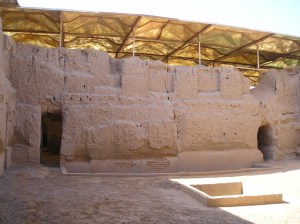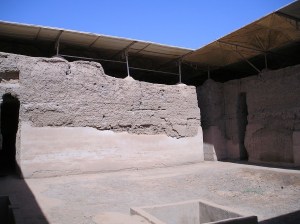My last offering on the history of the Fertile Crescent brought us to around 2100BCE with the fall of the Akkadian Empire and the house of Sargon the Great. Over the following years in the east there followed a succession of localised regional kingdoms and little is known of their culture and history. This was a period of great political and social uncertainty. States and kingdoms came and went, many rose and fell in a short time, waging war for the control of the prime fertile agricultural land of the area. The rulers were mostly military men who vied for power and joined in ever-changing alliances amid much betrayal. But gradually there was an order established.
One of the major groups involved in this period were the Martu or Amar but better known today as the Amorites. These are first mentioned in the writings of the Akkadian kingdoms dating from around 2200 BCE when there are references to the land of the Martu or the Mountains of the Martu. It is believed that these were the mountainous regions in the NW of modern-day Syria. At least 2 campaigns were fought by the Akkadians against the Martu.
It is clear the Akkadians did not hold the Martu in high regard, as these comments from Akkadian documents show:
The MAR.TU who know no grain…. The MAR.TU who know no house nor town, the boors of the mountains…. The MAR.TU who digs up truffles… who does not bend his knees (to cultivate the land), who eats raw meat, who has no house during his lifetime, who is not buried after death[.]
prepared wheat and gú-nunuz (grain) as a confection, but an Amorite will eat it without even recognizing what it contains!
They also give us an insight into the way the Martu lived and the scant evidence that is available suggests they were wandering nomadic tribes who occupied the Syrian and coastal plains moving from place to place with their herds.
Despite these disparaging references, there are others which tell of Martu or Amar troops fighting as mercenaries for other emerging city-states. So their military prowess was recognised and valued by their neighbours as mercenary forces and it is likely that this lead to the widespread expansion of Amorite influence across the Fertile Crescent in the years that followed.
In the north and the west of the fertile crescent, two kingdoms arose to take the lead, Mari and Yamkhad.
Little is known about the kingdom of Yamkhad, which probably occupied what today is Syria and Lebanon. There have been no internal written records found and what we do know comes from the records of surrounding countries. This was the Amorite homeland. It is very possible that Yamkhad was never a kingdom as such, but more an area controlled by a loose confederation of tribes who banded together only in the face of external danger.

Mari, however, was a classical city-state. Previously powerful it had gone through a decline and may have even been abandoned. However, it entered a new phase when a new ruling dynasty, a group of Amorites took control of the area establishing Mari as their capital. The first recorded leader, Yahdun-Lim is an interesting character. Despite his presumed “Western Levantine” origins, he re-introduced the Akkadian language and writing style as standard and also the Akkadian practice of using year names. I find it very interesting that he did this and I wonder if he was in fact already used to these having served as a mercenary in one of the post-Akkadian states where he had first encountered this language and customs. These reforms and his subsequent actions do not seem to represent the actions of a someone from a nomadic, non-writing culture. Alternatively, it may be that he came from a remnant of an Assyrian ruling family which had stayed on the western part of the Empire following its fall and that his conquest took a west to east direction. There is some evidence that some old Akkadian colonies in Asia Minor, had continued to flourish beyond the empire’s demise under the continuing leadership of a ruling Akkadian elite.
Yahdun-Lim embarked on a massive rebuilding programme and the Royal Palace of Mari became renowned throughout the region for its size and opulence. He quickly established Mari the dominant state in the area, with territory reaching from the Lebanese mountains in the west to the Tigris in the East. His impact was not only military as he seems to have worked on the irrigation systems to increase agricultural output of the area. However, such success, as we have previously seen was no guarantee of survival. As Yahdun-Lim’s forces pressed east they encountered the newly emergent kingdom of Upper Mesopotamia, led by their king Shamshi-Adad.
The remains of the Royal palace at Mari
Shamshi-Adad is also something of a mystery character. In some sources, he’s also referred to as an Amorite, but in others, we are told that he is of Assyrian descent. It has been suggested that he was the son of the ruler of the city of Ekallatum, which although it has never been located, was thought to be in the vicinity of Assur. This hypothesis suggests that he ruled there for about 10 years in the 1830s BCE, but was forced to leave when the city was conquered by forces from Eshnunna. He spent seven years in exile before returning to reclaim the throne, thereafter rapidly expanding the borders of his empire.
It was inevitable therefore that these two rapidly expanding kingdoms should come into conflict. This conflict seems to have produced a stalemate for some time, but around 1798 BCE Yahdun-Lim was assassinated and replaced on the throne of Mari by his son, about whom the records tell us very little. What we do know is that two or three years later the kingdom of Mari fell to the forces of Shamshi-Adad and he placed his youngest son Yasmah-Addu on the throne as ruler. There followed a period of remarkable stability in the area which would last some 20 years. However, in 1776 BCE, Shamshi-Adad died and Yasmah-Addu disappears from the historical record. It is uncertain exactly what happened but it seems likely that with the old King’s death, his empire just fell apart. Once again the area fragmented and new city-states rose up including one at Mari. The new King at Mari, Zimri-Lim quickly established control over the old Empire and much of Shamshi-Adad’s western kingdom. He appears to have been a remarkable diplomat establishing strong ties with the kingdoms to his East, especially newly emergent Babylon and with the Amorites in the West.

It would be remiss of us to pass on from Mari of this period, without reference to the Mari letters sometimes known as the Mari archive, which dates from this period. First discovered approximately 85 years ago during an excavation city of a royal palace dating from the 18th-century BCE, some 20,000 inscription tablets were found. Many of these were letters written between the palace and its court representatives, both domestic and foreign. Because of the strategic location of Mari, situated between the Syrian powers in the West and the Mesopotamian powers in the East, these letters are the prime source for understanding the history and politics of this period in the fertile crescent. These letters are carefully crafted documents and one almost unique feature of them is that the scribes often repeat or summarise the original request at the beginning of the document before going on to provide the answer. So often when looking at such correspondence, we only see one end of the conversation and must imagine the contents of the correspondence going in the other direction. Here in the Mari letters, we are fortunate to see both sides of the conversation. The economic, administrative and judicial texts provide information for assessing how goods and services were exchanged and of the legal traditions regulating such exchanges. The archive at Mari was not unique and similar collections have been found that other places in the Near East, though yielding a much smaller number of documents






I am also a semi-retired person working from home on independent research and (medical records!) consultancy. I’d be happy to share my thoughts on the Amorites, Yamhad, Mari, etc., though just doing this for a few years now.